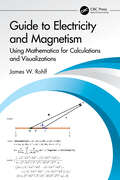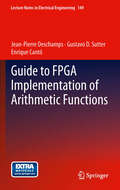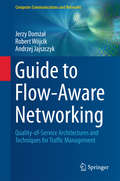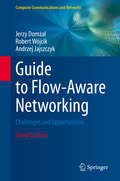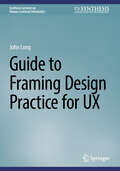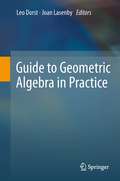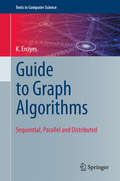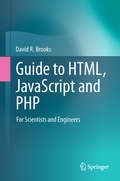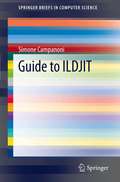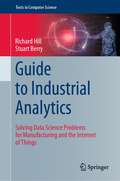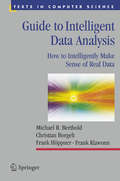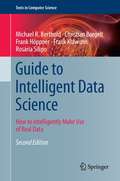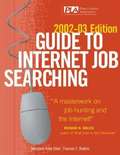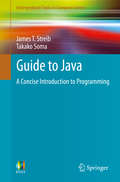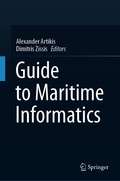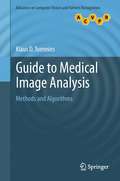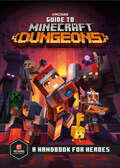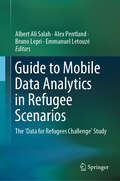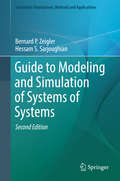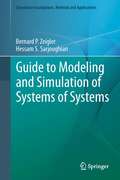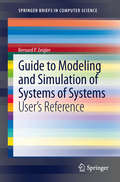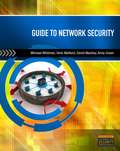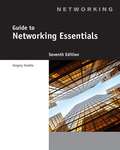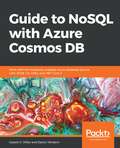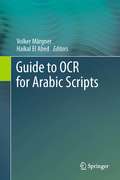- Table View
- List View
Guide to Electricity and Magnetism: Using Mathematica for Calculations and Visualizations
by James W. RohlfThis is a “how to guide” for a calculus-based introductory course in electricity and magnetism. Students taking the subject at an intermediate or advanced level may also find it to be a useful reference. The calculations are performed in Mathematica, and stress graphical visualization, units, and numerical answers. The techniques show the student how to learn the physics without being hung up on the math. There is a continuing movement to introduce more advanced computational methods into lower-level physics courses. Mathematica is a unique tool in that code is written as "human readable" much like one writes a traditional equation on the board.Key Features: Concise summary of the physics concepts. Over 300 worked examples in Mathematica. Tutorial to allow a beginner to produce fast results. The companion code for this book can be found here: https://physics.bu.edu/~rohlf/code.html
Guide to FPGA Implementation of Arithmetic Functions
by Enrique Cantó Gustavo D. Sutter Jean-Pierre DeschampsThis book is designed both for FPGA users interested in developing new, specific components - generally for reducing execution times -and IP core designers interested in extending their catalog of specific components. The main focus is circuit synthesis and the discussion shows, for example, how a given algorithm executing some complex function can be translated to a synthesizable circuit description, as well as which are the best choices the designer can make to reduce the circuit cost, latency, or power consumption. This is not a book on algorithms. It is a book that shows how to translate efficiently an algorithm to a circuit, using techniques such as parallelism, pipeline, loop unrolling, and others. Numerous examples of FPGA implementation are described throughout this book and the circuits are modeled in VHDL. Complete and synthesizable source files are available for download.
Guide to Flow-Aware Networking
by Jerzy Domżał Robert Wójcik Andrzej JajszczykThis book provides a practical guide to flow-aware networking (FAN), one of the most promising new quality-of-service architectures for the Future Internet. The latest concepts are examined in detail, including coverage of approximate flow-aware networking. The scope and evolution of the debate on network neutrality is also discussed. Topics and features: provides a broad survey of flow-oriented approaches and solutions based on the concept of flows; presents a range of mechanisms for improving transmission performance of streaming flows under congestion; illustrates how problems caused by congestion may be solved in a multilayer environment, proposing new methods for enhancing transmission in wired-wireless FAN; analyzes aspects of fair transmission in FAN, reviewing algorithms that improve transmission of streaming flows during network failures; describes the implementation aspects of the cross-protect router; concludes each chapter with review questions, with answers provided at the end of the book.
Guide to Flow-Aware Networking: Challenges and Opportunities (Computer Communications and Networks #0)
by Jerzy Domżał Robert Wójcik Andrzej JajszczykThe book presents a comprehensive view on Flow-Aware Networking. It starts with a brief overview of the known QoS architectures based on the concept of a flow. Then, the original FAN concept is presented, along with its variations proposed by the authors. The next chapter covers a very valuable feature of the FAN architecture, namely its ability to assure net neutrality. The chapters that follow will discuss, in detail, a variety of issues making the FAN concept implementable, including congestion control, fairness, resilience to failures, service differentiation and degradation. The final chapter presents the test implementation of the FAN router, including the environment used and performance tests. Chapters are supplemented with problems to solve, along with their solutions. The pedagogical character of the book is supported by a number of illustrative examples contained in most of the chapters. At the end of the book, a glossary of the key terms is included, along with a comprehensive bibliography.Flow-based traffic management is currently becoming a mainstream. There is plenty of Quality of Service (QoS) techniques based on flows. Software-Defined Networking with its dominant protocol OpenFlow also follows this trend. Flow-Aware Networking (FAN) is a promising QoS architecture. Information on FAN can be found in various research papers. It is, therefore highly scattered. This book gathers practically all relevant information regarding FAN and puts it together.Quality of Service assurance is one of the key challenges of today’s Internet. The existing approaches to provide QoS do not meet expectations of network operators, managers and users although numerous efforts in this area have been reported. One of the most promising concepts is the Flow-Aware Network (FAN). FAN can play a key role in assuring the net neutrality, smoothly combining interests of all the involved parties. The authors of the proposal have been involved in FAN research practically since its inception at the start of the 21st century. The book reports the wide experiences the authors accumulated in the subject area during the work on common FAN-related projects conducted with the team of James Roberts that proposed the original FAN concept as well as other leading research groups in Europe and the USA. One of the aims of the book is to accompany courses taught by the authors.
Guide to Framing Design Practice for UX (Synthesis Lectures on Human-Centered Informatics)
by John LongThe scope of the book is UX. It presents a comprehensive guide for readers to better engage with the framing of UX design practice. The guide characterises UX as a movement, whose members are developing shared ideas to specify and to implement HCI (Human-Computer Interaction) as UX. The book is based on the analysis of the conduct and reporting of framing UX design practice, contributed by experienced UX practitioners. It surveys the various means by which UX practitioners conduct and report their design practices. These include trial and error; implement, test, and specify; and implement, evaluate, and iterate. These practices apply UX frameworks, UX approaches, and UX methods and are typically reported in the form of UX case studies. The book differs from top-down, formal, and framework-driven approaches. In contrast, it takes a bottom-up, informal, and practice-driven approach. In a dynamic field such as UX, there is seldom time to stop and think about the wider issues associated with design practice and its related trends. But this book creates that opportunity for UX practitioners to locate and reflect on their design practice—what they are doing and why they are doing it. The guide creates a space in which UX practitioners are informed of current trends that they can incorporate into their own workflows. Readers benefiting from this book include those working in customer experience design, experience-centred design, and human experience design. It will also be of interest to undergraduate and graduate students trying to make sense of the different ways of conducting and reporting HCI as UX. Further, it provides grounding for young researchers making their way in the fast developing world of UX.
Guide to Geometric Algebra in Practice
by Leo Dorst Joan LasenbyThis highly practical Guide to Geometric Algebra in Practice reviews algebraic techniques for geometrical problems in computer science and engineering, and the relationships between them. The topics covered range from powerful new theoretical developments, to successful applications, and the development of new software and hardware tools. Topics and features: provides hands-on review exercises throughout the book, together with helpful chapter summaries; presents a concise introductory tutorial to conformal geometric algebra (CGA) in the appendices; examines the application of CGA for the description of rigid body motion, interpolation and tracking, and image processing; reviews the employment of GA in theorem proving and combinatorics; discusses the geometric algebra of lines, lower-dimensional algebras, and other alternatives to 5-dimensional CGA; proposes applications of coordinate-free methods of GA for differential geometry.
Guide to Graph Algorithms: Sequential, Parallel And Distributed (Texts in Computer Science)
by K ErciyesThis clearly structured textbook/reference presents a detailed and comprehensive review of the fundamental principles of sequential graph algorithms, approaches for NP-hard graph problems, and approximation algorithms and heuristics for such problems. The work also provides a comparative analysis of sequential, parallel and distributed graph algorithms – including algorithms for big data – and an investigation into the conversion principles between the three algorithmic methods.Topics and features: presents a comprehensive analysis of sequential graph algorithms; offers a unifying view by examining the same graph problem from each of the three paradigms of sequential, parallel and distributed algorithms; describes methods for the conversion between sequential, parallel and distributed graph algorithms; surveys methods for the analysis of large graphs and complex network applications; includes full implementation details for the problems presented throughout the text; provides additional supporting material at an accompanying website.This practical guide to the design and analysis of graph algorithms is ideal for advanced and graduate students of computer science, electrical and electronic engineering, and bioinformatics. The material covered will also be of value to any researcher familiar with the basics of discrete mathematics, graph theory and algorithms.
Guide to HTML, JavaScript and PHP
by David R. BrooksThis book enables readers to quickly develop a working knowledge of HTML, JavaScript and PHP. The text emphasizes a hands-on approach to learning and makes extensive use of examples. A detailed science, engineering, or mathematics background is not required to understand the material, making the book ideally suitable for self-study or an introductory course in programming. Features: describes the creation and use of HTML documents; presents fundamental concepts of client-side and server-side programming languages; examines JavaScript and PHP implementation of arrays, built-in and user-defined methods and functions, math capabilities, and input processing with HTML forms; extends programming fundamentals to include reading and writing server-based files, command-line interfaces, and an introduction to GD graphics; appendices include a brief introduction to using a "pseudocode" approach to organizing solutions to computing problems; includes a Glossary and an extensive set of programming exercises.
Guide to ILDJIT
by Simone CampanoniThis book is a guide to getting started with ILDJIT, a compilation framework designed to be both easily extensible and easily configurable. Within this framework, it is possible to build a tool-chain by customizing ILDJIT for specific purposes. Customizations can be used within both static and dynamic compilers already included in the framework without adaptations. Moreover, customizations allow modification of both the behaviors and the characteristics of these compilers to better satisfy the particular need. Currently, ILDJIT is able to translate bytecode programs to generate machine code for both Intel x86 and ARM processors. By relying on ILDJIT technology, more input languages or platforms can be supported. After an introduction to ILDJIT, this guide goes into detail on how to exploit it by extending the framework to match specific requirements. Finally, there is an introduction and discussion of the design choices followed during the authors' years of development efforts towards ILDJIT.
Guide to Industrial Analytics: Solving Data Science Problems for Manufacturing and the Internet of Things (Texts in Computer Science)
by Richard Hill Stuart BerryThis textbook describes the hands-on application of data science techniques to solve problems in manufacturing and the Industrial Internet of Things (IIoT). Monitoring and managing operational performance is a crucial activity for industrial and business organisations. The emergence of low-cost, accessible computing and storage, through Industrial Digital Technologies (IDT) and Industry 4.0, has generated considerable interest in innovative approaches to doing more with data. Data science, predictive analytics, machine learning, artificial intelligence and general approaches to modelling, simulating and visualising industrial systems have often been considered topics only for research labs and academic departments.This textbook debunks the mystique around applied data science and shows readers, using tutorial-style explanations and real-life case studies, how practitioners can develop their own understanding of performance to achieve tangible business improvements. All exercises can be completed with commonly available tools, many of which are free to install and use.Readers will learn how to use tools to investigate, diagnose, propose and implement analytics solutions that will provide explainable results to deliver digital transformation.
Guide to Intelligent Data Analysis
by Frank Klawonn Christian Borgelt Frank Höppner Michael R. BertholdEach passing year bears witness to the development of ever more powerful computers, increasingly fast and cheap storage media, and even higher bandwidth data connections. This makes it easy to believe that we can now - at least in principle - solve any problem we are faced with so long as we only have enough data. Yet this is not the case. Although large databases allow us to retrieve many different single pieces of information and to compute simple aggregations, general patterns and regularities often go undetected. Furthermore, it is exactly these patterns, regularities and trends that are often most valuable. To avoid the danger of "drowning in information, but starving for knowledge" the branch of research known as data analysis has emerged, and a considerable number of methods and software tools have been developed. However, it is not these tools alone but the intelligent application of human intuition in combination with computational power, of sound background knowledge with computer-aided modeling, and of critical reflection with convenient automatic model construction, that results in successful intelligent data analysis projects. Guide to Intelligent Data Analysis provides a hands-on instructional approach to many basic data analysis techniques, and explains how these are used to solve data analysis problems. Topics and features: guides the reader through the process of data analysis, following the interdependent steps of project understanding, data understanding, data preparation, modeling, and deployment and monitoring; equips the reader with the necessary information in order to obtain hands-on experience of the topics under discussion; provides a review of the basics of classical statistics that support and justify many data analysis methods, and a glossary of statistical terms; includes numerous examples using R and KNIME, together with appendices introducing the open source software; integrates illustrations and case-study-style examples to support pedagogical exposition. This practical and systematic textbook/reference for graduate and advanced undergraduate students is also essential reading for all professionals who face data analysis problems. Moreover, it is a book to be used following one's exploration of it. Dr. Michael R. Berthold is Nycomed-Professor of Bioinformatics and Information Mining at the University of Konstanz, Germany. Dr. Christian Borgelt is Principal Researcher at the Intelligent Data Analysis and Graphical Models Research Unit of the European Centre for Soft Computing, Spain. Dr. Frank Höppner is Professor of Information Systems at Ostfalia University of Applied Sciences, Germany. Dr. Frank Klawonn is a Professor in the Department of Computer Science and Head of the Data Analysis and Pattern Recognition Laboratory at Ostfalia University of Applied Sciences, Germany. He is also Head of the Bioinformatics and Statistics group at the Helmholtz Centre for Infection Research, Braunschweig, Germany.
Guide to Intelligent Data Science: How to Intelligently Make Use of Real Data (Texts in Computer Science)
by Frank Klawonn Christian Borgelt Frank Höppner Michael R. Berthold Rosaria SilipoMaking use of data is not anymore a niche project but central to almost every project. With access to massive compute resources and vast amounts of data, it seems at least in principle possible to solve any problem. However, successful data science projects result from the intelligent application of: human intuition in combination with computational power; sound background knowledge with computer-aided modelling; and critical reflection of the obtained insights and results.Substantially updating the previous edition, then entitled Guide to Intelligent Data Analysis, this core textbook continues to provide a hands-on instructional approach to many data science techniques, and explains how these are used to solve real world problems. The work balances the practical aspects of applying and using data science techniques with the theoretical and algorithmic underpinnings from mathematics and statistics. Major updates on techniques and subject coverage (including deep learning) are included.Topics and features: guides the reader through the process of data science, following the interdependent steps of project understanding, data understanding, data blending and transformation, modeling, as well as deployment and monitoring; includes numerous examples using the open source KNIME Analytics Platform, together with an introductory appendix; provides a review of the basics of classical statistics that support and justify many data analysis methods, and a glossary of statistical terms; integrates illustrations and case-study-style examples to support pedagogical exposition; supplies further tools and information at an associated website.This practical and systematic textbook/reference is a “need-to-have” tool for graduate and advanced undergraduate students and essential reading for all professionals who face data science problems. Moreover, it is a “need to use, need to keep” resource following one's exploration of the subject.
Guide to Internet Job Searching: 2002-03 Edition
by Frances E. Roehm Margaret Riley DikelCopublished by America's foremost career books publisher and the Public Library Association, the acclaimed Guide to Internet Job Searching helps you harness the power of the Internet to aid in your job search. The Internet has revolutionized the way people look for career opportunities, and with this guide, you, too, can efficiently and successfully explore the Web to find the right job for you. This bestselling guide shows you how to target the most interesting jobs in the most promising companies and apply for those jobs with confidence-online or on paper. And it will steer you away from electronic "dead ends" such as unproductive searches that turn up thousands of near misses. Whether you are a complete beginner or an online expert, you'll find invaluable advice inside to make your Internet job search streamlined, efficient, and effective-from logging on to landing the perfect job. Margaret Riley Dikel, author of The Riley Guide (rileyguide.com), is a private consultant specializing in the use of the Internet for employment and career information. She is an internationally recognized authority in this field, having worked for many prominent governmental agencies and public and private corporations. Frances E, Roehm is the SkokieNet librarian at the Skokie (Illinois) Public Library where she specializes in building the village's community online. She is also the webmaster for ChicagoJobs.org, a regional resource for Chicagoland job hunters and career changers, and assists individuals in using the Internet to find a job. She currently chairs the PLA Job and Career Information Services committee.
Guide to Java
by James T. Streib Takako SomaThis book presents a focused and accessible primer on the fundamentals of Java programming, with extensive use of examples and hands-on exercises. Topics and features: provides an introduction to variables, input/output and arithmetic operations; describes objects and contour diagrams, explains selection structures, and demonstrates how iteration structures work; discusses object-oriented concepts such as overloading and classes methods, and introduces string variables and processing; illustrates arrays and array processing and examines recursion; explores inheritance and polymorphism and investigates elementary files; presents a primer on graphical input/output, discusses elementary exception processing, and presents the basics of Javadoc; includes exercises at the end of each chapter, with selected answers in an appendix and a glossary of key terms; provides additional supplementary information at an associated website.
Guide to Maritime Informatics
by Alexander Artikis Dimitris ZissisIn the last 25 years, information systems have had a disruptive effect on society and business. Up until recently though, the majority of passengers and goods were transported by sea in many ways similar to the way they were at the turn of the previous century. Gradually, advanced information technologies are being introduced, in an attempt to make shipping safer, greener, more efficient, and transparent. The emerging field of Maritime Informatics studies the application of information technology and information systems to maritime transportation.Maritime Informatics can be considered as both a field of study and domain of application. As an application domain, it is the outlet of innovations originating from data science and artificial intelligence; as a field of study, it is positioned between computer science and marine engineering. This new field’s complexity lies within this duality because it is faced with disciplinary barriers yet demands a systemic, transdisciplinary approach. At present, there is a growing body of knowledge that remains undocumented in a single source or textbook designed to assist students and practitioners.This highly useful textbook/reference starts by introducing required knowledge, algorithmic approaches, and technical details, before presenting real-world applications. The aim is to present interested audiences with an overview of the main technological innovations having a disruptive effect on the maritime industry, as well as to discuss principal ideas, methods of operation and applications, and future developments. The material in this unique volume provides requisite core knowledge for undergraduate or postgraduate students, employing an analytical approach with numerous real-world examples and case studies.
Guide to Medical Image Analysis
by Klaus D. ToenniesThis book presents a comprehensive overview of medical image analysis. Practical in approach, the text is uniquely structured by potential applications. Features: presents learning objectives, exercises and concluding remarks in each chapter, in addition to a glossary of abbreviations; describes a range of common imaging techniques, reconstruction techniques and image artefacts; discusses the archival and transfer of images, including the HL7 and DICOM standards; presents a selection of techniques for the enhancement of contrast and edges, for noise reduction and for edge-preserving smoothing; examines various feature detection and segmentation techniques, together with methods for computing a registration or normalisation transformation; explores object detection, as well as classification based on segment attributes such as shape and appearance; reviews the validation of an analysis method; includes appendices on Markov random field optimization, variational calculus and principal component analysis.
Guide to Minecraft Dungeons: A Handbook for Heroes (Minecraft)
by Mojang AB The Official Minecraft TeamWith insider info and tips from the experts at Mojang, this is the definitive guide to Minecraft Dungeons.It is a dark and dangerous time. Corrupted by the Orb of Dominance, the evil Arch-Illager has gathered a loyal following of Illagers. Together they have ravaged the land, enslaving the peaceful Villagers and forcing them to do their bidding. The Villagers are in desperate need of a hero, and you are their only hope. Within the pages of this valuable book, you will find strategies for fighting malicious mobs, observations about the perils of each dungeon and advice about how to get your hands on rare and powerful items. You will also learn how to work as part of a team to vanquish the Arch-Illager once and for all.The fate of us all lies in your hands, brave hero. The Arch-Illager&’s reign of terror ends now.
Guide to Mobile Data Analytics in Refugee Scenarios: The 'Data for Refugees Challenge' Study
by Yves-Alexandre de Montjoye Xiaowen Dong Patrick VinckAfter the start of the Syrian Civil War in 2011–12, increasing numbers of civilians sought refuge in neighboring countries. By May 2017, Turkey had received over 3 million refugees — the largest refugee population in the world. Some lived in government-run camps near the Syrian border, but many have moved to cities looking for work and better living conditions. They faced problems of integration, income, welfare, employment, health, education, language, social tension, and discrimination. In order to develop sound policies to solve these interlinked problems, a good understanding of refugee dynamics isnecessary.This book summarizes the most important findings of the Data for Refugees (D4R) Challenge, which was a non-profit project initiated to improve the conditions of the Syrian refugees in Turkey by providing a database for the scientific community to enable research on urgent problems concerning refugees. The database, based on anonymized mobile call detail records (CDRs) of phone calls and SMS messages of one million Turk Telekom customers, indicates the broad activity and mobility patterns of refugees and citizens in Turkey for the year 1 January to 31 December 2017. Over 100 teams from around the globe applied to take part in the challenge, and 61 teams were granted access to the data.This book describes the challenge, and presents selected and revised project reports on the five major themes: unemployment, health, education, social integration, and safety, respectively. These are complemented by additional invited chapters describing related projects from international governmental organizations, technological infrastructure, as well as ethical aspects. The last chapter includes policy recommendations, based on the lessons learned.The book will serve as a guideline for creating innovative data-centered collaborations between industry, academia, government, and non-profit humanitarian agencies to deal with complex problems in refugee scenarios. It illustrates the possibilities of big data analytics in coping with refugee crises and humanitarian responses, by showcasing innovative approaches drawing on multiple data sources, information visualization, pattern analysis, and statistical analysis.It will also provide researchers and students working with mobility data with an excellent coverage across data science, economics, sociology, urban computing, education, migration studies, and more.
Guide to Modeling and Simulation of Systems of Systems
by Hessam S. Sarjoughian Bernard P. ZeiglerThis guide demonstrates how virtual build and test can be supported by the Discrete Event Systems Specification (DEVS) simulation modeling formalism, and the System Entity Structure (SES) simulation model ontology. The book examines a wide variety of Systems of Systems (SoS) problems, ranging from cloud computing systems to biological systems in agricultural food crops. Features: includes numerous exercises, examples and case studies throughout the text; presents a step-by-step introduction to DEVS concepts, encouraging hands-on practice to building sophisticated SoS models; illustrates virtual build and test for a variety of SoS applications using both commercial and open source DEVS simulation environments; introduces an approach based on activity concepts intrinsic to DEVS-based system design, that integrates both energy and information processing requirements; describes co-design modeling concepts and methods to capture separate and integrated software and hardware systems.
Guide to Modeling and Simulation of Systems of Systems
by Jean-Christophe Soulié Raphaël Duboz Hessam S. Sarjoughian Bernard ZeiglerThis guide demonstrates how virtual build and test can be supported by the Discrete Event Systems Specification (DEVS) simulation modeling formalism, and the System Entity Structure (SES) simulation model ontology. The book examines a wide variety of Systems of Systems (SoS) problems, ranging from cloud computing systems to biological systems in agricultural food crops. Features: includes numerous exercises, examples and case studies throughout the text; presents a step-by-step introduction to DEVS concepts, encouraging hands-on practice to building sophisticated SoS models; illustrates virtual build and test for a variety of SoS applications using both commercial and open source DEVS simulation environments; introduces an approach based on activity concepts intrinsic to DEVS-based system design, that integrates both energy and information processing requirements; describes co-design modeling concepts and methods to capture separate and integrated software and hardware systems.
Guide to Modeling and Simulation of Systems of Systems: User's Reference
by Bernard ZeiglerThis user's reference is a companion to the separate book also titled "Guide to Modelling and Simulation of Systems of Systems." The principal book explicates integrated development environments to support virtual building and testing of systems of systems, covering in some depth the MS4 Modelling EnvironmentTM. This user's reference provides a quick reference and exposition of the various concepts and functional features covered in that book. The topics in the user's reference are grouped in alignment with the workflow displayed on the MS4 Modeling EnvironmentTM launch page, under the headings Atomic Models, System Entity Structure, Pruning SES, and Miscellaneous. For each feature, the reference discusses why we use it, when we should use it, and how to use it. Further comments and links to related features are also included.
Guide to Network Security
by Michael E. Whitman Herbert J. Mattord David Mackey Andrew GreenThe authors then explore network perimeter defense technologies and methods, including access controls, firewalls, VPNs, and intrusion detection systems, as well as applied cryptography in public key infrastructure, wireless security, and web commerce. The final section covers additional topics relevant for information security practitioners, such as assessing network security, professional careers in the field, and contingency planning. Perfect for both aspiring and active IT professionals.
Guide to Networking Essentials
by Greg TomshoGUIDE TO NETWORKING ESSENTIALS provides students with both the knowledge and hands-on skills necessary to work with network operating systems in a network administration environment. By focusing on troubleshooting and computer networking technologies, this book offers a comprehensive introduction to networking and to advances in software, wireless and network security.
Guide to NoSQL with Azure Cosmos DB: Work with the massively scalable Azure database service with JSON, C#, LINQ, and .NET Core 2
by Gastón C. Hillar Daron YöndemCreate scalable applications by taking advantage of NoSQL document databases on the cloud with .NET CoreKey FeaturesWork with the latest available tools related to Cosmos DBLearn to work with the latest version of the .NET Core SDK, C# and the SQL APIWork with a database service that doesn’t require you to use an ORM and provides flexibilityBook DescriptionCosmos DB is a NoSQL database service included in Azure that is continuously adding new features and has quickly become one of the most innovative services found in Azure, targeting mission-critical applications at a global scale. This book starts off by showing you the main features of Cosmos DB, their supported NoSQL data models and the foundations of its scalable and distributed architecture. You will learn to work with the latest available tools that simplify your tasks with Cosmos DB and reduce development costs, such as the Data Explorer in the Azure portal, Microsoft Azure Storage Explorer, and the Cosmos DB Emulator.Next, move on to working with databases and document collections. We will use the tools to run schema agnostic queries against collections with the Cosmos DB SQL dialect and understand their results. Then, we will create a first version of an application that uses the latest .NET Core SDK to interact with Cosmos DB. Next, we will create a second version of the application that will take advantage of important features that the combination of C# and the .NET Core SDK provides, such as POCOs and LINQ queries. By the end of the book, you will be able to build an application that works with a Cosmos DB NoSQL document database with C#, the .NET Core SDK, LINQ, and JSON.What you will learnUnderstand the supported NoSQL data models and the resource hierarchyLearn the latest tools to work with Cosmos DB accounts and collectionsReduce your development costs by working with the Cosmos DB EmulatorUnderstand request units, automatic indexing, partitioning, and billingBuild an application with C#, Cosmos DB, .NET Core SDK, and the SQL APIPerform asynchronous operations with databases, and documents in C#Work with models, and customize serialization of LINQ queriesWho this book is forThis book is for C# developers. You do not require any knowledge of Azure Cosmos DB, but familiarity with the Azure platform is expected.
Guide to OCR for Arabic Scripts
by Volker Märgner Haikal El AbedThis Guide to OCR for Arabic Scripts is the first book of its kind, specifically devoted to this emerging field. Topics and features: contains contributions from the leading researchers in the field; with a Foreword by Professor Bente Maegaard of the University of Copenhagen; presents a detailed overview of Arabic character recognition technology, covering a range of different aspects of pre-processing and feature extraction; reviews a broad selection of varying approaches, including HMM-based methods and a recognition system based on multidimensional recurrent neural networks; examines the evaluation of Arabic script recognition systems, discussing data collection and annotation, benchmarking strategies, and handwriting recognition competitions; describes numerous applications of Arabic script recognition technology, from historical Arabic manuscripts to online Arabic recognition.
